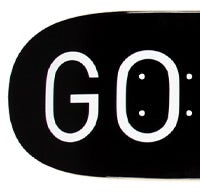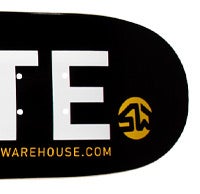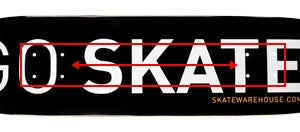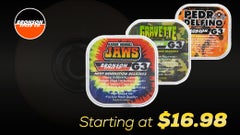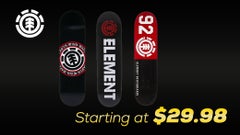

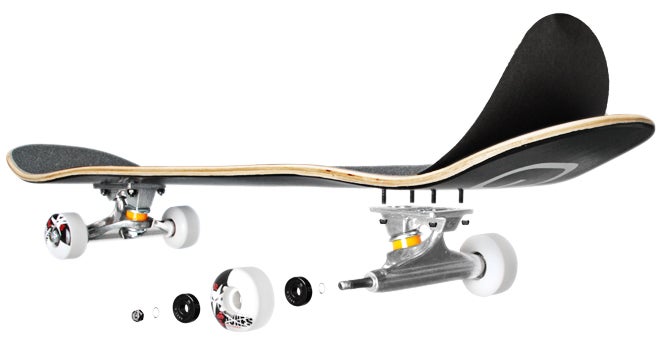
Deck Parts
Grip Tape
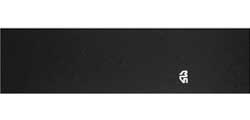
Description: Griptape is the sandpaper like sheet that is applied to the top of the deck. It is usually 9" wide by 33" long and is self adhesive. The Griptape is grainy because in order to have control and traction of your skate board, you need a substance that will catch and grab all the movement of your feet.
Truck Parts
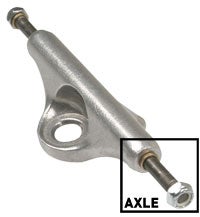
Corresponding Part: Truck
Description: The axle is a metal rod that runs through the truck hanger, protruding a couple of inches on either side. One wheel is inserted on either end and held in place by the axle nut.
Additional Info: Occasionally, after much abuse, a truck axle will begin to "slip." When this happens the truck axle slides a bit to one side, loosening one wheel and tightening the other. Tapping it back into position will remedy this temporarily - but if your trucks are this thrashed it may be a good idea just to invest in a fresh pair. The diameter of every industry standard truck axle is the same, however, lengths vary to accomodate different deck widths.
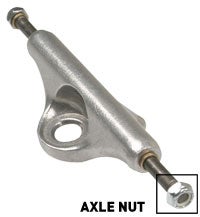
Corresponding Part: Truck
Description: An axle nut is threaded onto the truck axle to hold the wheel in place.
Additional Info: After much abuse, the axle nut and/or the end of the axle itself can become worn enough that removing or attaching the nut becomes difficult or impossible. If this happens, try flipping the nut upside down, using a different nut, or replacing the truck altogether. Silver Trucks have a unique shield which is threaded into the end of the axle to prevent this from happening.
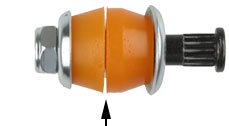
Corresponding Part: Truck
Description: Bushings are donut-shaped urethane pieces that are inserted onto the kingpin of a truck. There are 2 bushings per truck, 1 above and 1 below where the hanger fits onto the kingpin. Adjusting the kingpin nut to tighten or loosen the bushings will adjust the turning radius and response of the truck itself. Tighter bushings mean stiffer trucks and less chance of wheel bite, while loose bushings make for easier turning but a greater chance of wheel bite disaster.
Additional Info: Sometimes new bushings will be naturally stiff, causing the truck hanger to be offset and your wheels to rest unevenly on the ground. Don't flip out, this is fairly common. To correct this just start skating and make a point to turn a bunch in both directions on each truck, forcing the urethane bushings to soften up a bit. Also, not all bushings fit every truck.
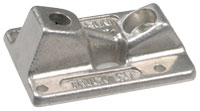
Corresponding Part: Truck
Description: This is the componant of a truck that is physically attached to the board with the mounting hardware. A baseplate consists of the plate itself (with 4 or 6 mounting holes) and it's supported kingpin and pivot cup. The truck hanger then fits snugly into the pivot cup and over the kingpin, which is held in place by the king pin nut.
Additional Info: Tensor trucks are designed with a hard plastic insert on the kicktail side of the baseplates that makes slides against rough surfaces easier to pull. These Tensor Custom Color Kits, which include pivot cups, are replaceable and come in several different colors.

Corresponding Part: Truck
Description: The truck hanger is fastened to the kingpin and rests in the pivot cup of the baseplate. It contains the axle on which your wheels are mounted and provides the surface we so relentlessly grind on.
Additional Info: Hangers are brand specific, meaning they are not interchangeable with other truck companies' baseplates.

Corresponding Part: Truck
Description: A pivot cup is a plastic cup-shaped piece that rests inside the baseplate and supports the trucks hanger at the pivot point, allowing it to turn smoothly in either left or right directions.
Additional Info: After much abuse, a pivot cup may begin to wear down in spots causing the truck hanger to pivot unevenly. If this happens, a replacement pivt cup is a good investment.

Corresponding Part: Truck
Description: The kingpin is a partially threaded bolt protruding from the baseplate that supports the bushings and truck hanger. The axle nut at the end can be adjusted to loosen or tighten the turning capacity of your truck.
Additional Info: Some trucks' king pins are replacable.

Corresponding Part: Truck
Description: The king pin nut, which keeps the truck hanger and bushings in place, can be adjusted to tighten or loosen your trucks.
Hardware

Description: Hardware is sold in a set of 8 bolts and 8 nuts. Hardware allows you to connect your deck to your trucks. Skate Warehouse has a large selection of sizes and brands. The size of the risers you choose for your complete will dictate which size hardware you should use. The choice is yours.
Wheel Parts
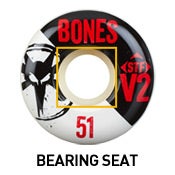
Corresponding Part: Wheel
Description: The bearing seat of a wheel is part of it's core and keeps the bearing vertically positioned and centered inside the wheel. 1 bearing is fitted against each side of the bearing seat of a wheel.
Additional Info: Spacers act as a kind of additional bearing seat, keeping the center rings of both bearings equally spaced and vertically positioned.

Corresponding Part: Wheel
Description: MM or mm is the diameter (or height) of a skateboard wheel in millimeters.
Additional Info: The typical size range of wheels for street and vert skateboarding ranges from 45-60mm. Larger wheels can be used no prob, but thicker risers may be required to allow enough clearance under the board to prevent wheelbite.
Corresponding Part: Wheel
Description: Durometer is the international standard for the hardness measurement of rubber, plastic, and other nonmetallic materials. There are several types of durometers, each designed to measure a particular range of materials. Skateboard-wheel urethane is most commonly measured on the A scale, however B and D have become more recently adopted by some companies for accuracy and dual-durometer wheels. 99A, 82B, and 45D are roughly the same durometer.
Additional Info: For more information on durometer, check out: http://www.skateboarding.com/skate/magazine/article/0,12768,200408,00.html

Corresponding Part: Wheel
Description: Cores are the center of the wheel where you will insert the bearing. Some wheels are designed with a core of higher durometer urethane to increase durability and sometimes decrease weight. Cores can also be made from solid plastic or hollowed out plastic. Core designs vary from brand to brand.
Bearing Parts
Corresponding Part: Bearing
Description: (Annual Bearing Evaluation Committee) Ratings follow numerical values of 1,2,3,4,5,6,7,8,9 and are precision ratings as to how well a bearing performs under high speeds in a straight line.
Additional Info: Considering the fact that the ABEC rating is applied for industrial machine operations and purposes, ABEC means very little in skateboarding. The fact is, Skateboarding introduces forces and strains that a bearing was never intended to handle. Side loads and high energy impact can break down a bearing at any rating level.
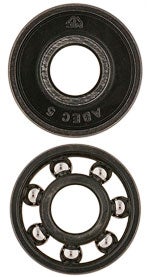
Corresponding Part: Bearing
Description: Skateboard bearings allow for the rolling motion of a wheel on it's axle. They consist of 6, 7 or 8 balls enclosed in races between two shields encased in a disklike body. 2 bearings, 1 on each side, are inserted into every wheel, totalling 8 bearings necessary for a complete skateboard.
Additional Info: Industry standard skateboard bearings are of one universal size, except for Element Micro Bearings which can be adapted to fit their respective Micro-Core wheels. The shields of some bearings (including Bones, etc...) are removable to allow for cleaning and lubrication. See also ABEC,...
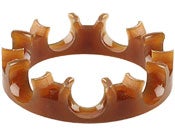
Corresponding Part: Bearing
Description: Delrin crowns hold and seperate the individual balls within a bearing. By keeping the ball bearings lubricated and clean within their delrin crowns, you can lengthen the life and strengthen the performance of your bearings.
Additional Info: Crowns are also sometimes called retainers or cages.
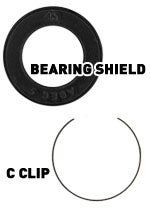
Corresponding Part: Bearing
Description: The bearing shield is essentially the side of the bearing, which keeps dirt from getting in and the ball bearings and/or delrin crowns from falling out. Often there is a C clip to keep the shields in place.
Additional Info: Some bearings shields are removable to allow for cleaning and maintenance. Bearings with removable bearing shields include:
Corresponding Part: Bearing
Description: The C clip is a mechanism for locking bearing shields in place. It's basically a thin C-shaped wire that fits tightly into a groove around the outside perimeter of the bearing shield to hold it in place against the bearing casing. Not all bearings have them, but those that do can typically be taken apart for cleaning and maintainence.
Corresponding Part: Bearing
Description: Lubricant is the sauce that keeps your bearings rolling quick and quiet. It is a synthetic blend of low viscosity, high speed oils that minimize friction within the bearing and allow them stay spinning smooth.
Additional Info: New bearings are already lubricated but due to the abuse we dish out they do get dirty after a while. If you don't want to buy new ones, clean them up and try squirtin' some Bones Speed Cream, Reflex Bearing Lubricant or FKD Bearing Lubricant in there to keep them rolling like new. It's a good idea to maintain your bearings on a monthly basis.
Corresponding Part: Bearing
Description: A spacer is a tubular piece that fits within the bearing seat of a wheel, between the two bearings, to keep them evenly spaced and vertcally aligned. Spacers are not necessary, but they do slightly improve the performance and durablity of your bearings.
Additional Info: Some bearings include a set of spacers, though most do not. Check out the Destructo Accelerator Kit.
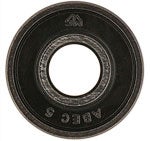
Corresponding Part: Bearing
Description: The casing is the disklike metal body of a bearing in which the shields, crowns and balls are housed.

Corresponding Part: Bearing
Description: The balls in a bearing are contained by delrin crowns that allow the bearing casing to spin around them.
Additional Info: Most bearings contain 7 ball bearings, however the Bones Super Swiss Six Bearings contain 6 bigger balls for increased strength and speed.
